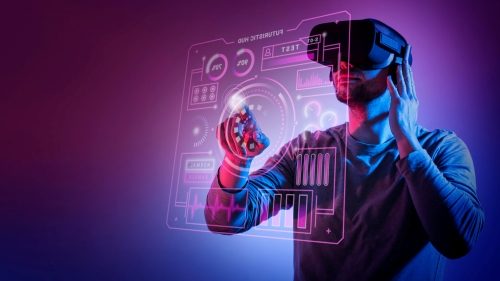Web design is constantly evolving, and staying on top of the latest trends is crucial for businesses and developers to remain competitive in the digital landscape. As we move into 2025, a blend of cutting-edge technologies, creative aesthetics, and user-centric functionality is shaping the web design world. ABM College is committed to teaching the latest designs and skills necessary for graduates to continue evolving with the industry. Let’s dive into some of the key trends that will dominate the web design scene in the coming years.
AI-Driven Web Design

Like most tech related fields, Artificial Intelligence (AI) continues to revolutionize web design. In 2025, AI-powered tools will make web development more intuitive and accessible, automating tasks like layout design, color scheme recommendations, and even content creation. With AI-driven personalization, websites can now dynamically adapt content to each user’s preferences, behaviors, and location, making for more engaging experiences.
AI chatbots are also expected to get smarter, handling complex user queries with ease and providing 24/7 support without compromising quality. While it can’t replace human support, it does offer support outside typical business hours, and additional support for small businesses with minimal staff.
Dark Mode 2.0
Dark mode has been popular for some time, but 2025 will see it taken to the next level. Designers are going beyond the simple inversion of colors by implementing more dynamic, high-contrast dark themes with accent colors and glowing effects. These dark themes not only reduce eye strain but also enhance battery efficiency on OLED screens, making them both functional and aesthetically pleasing.
Expect to see more websites offering automatic dark mode switching based on time of day or user preference.
3D Elements and Immersive Interactions

With the rise of powerful web technologies like WebGL and Three.js, 3D elements are becoming more common in web design. In 2025, expect to see even more immersive experiences where users can interact with 3D models, scroll-triggered animations, and parallax effects. This trend will create more visually engaging websites, ideal for industries like architecture, product design, and gaming.
Web design is also shifting towards creating deeper, more meaningful interactions, where users are drawn in through animated elements, hover effects, and micro-interactions.
Minimalism Meets Maximalism
The minimalist design approach has long been favored for its simplicity and clarity, but in the coming years, designers are starting to blend minimalist aesthetics with maximalist elements. This fusion allows for clean designs that still feel rich and vibrant, using bold typography, oversized imagery, and dynamic backgrounds without overwhelming the user.
Minimalist designs will continue to focus on functionality, while maximalist touches will add personality and a wow factor to websites.
Augmented Reality (AR) Integration

Augmented reality is no longer just a feature for mobile apps – it’s making its way into web design. With WebAR technology becoming more accessible, websites can now offer AR experiences without the need for a dedicated app. This trend is especially valuable for eCommerce, where users can preview products in their space before buying, or for educational sites that offer interactive learning experiences.
AR will be a game-changer in creating more immersive and interactive web environments.
Visual Aesthetics with Depth
While flat design has dominated for years, “neumorphism” and “glassmorphism” are stepping into the spotlight in 2025. Neumorphism creates the illusion of physical buttons, while glassmorphism uses a frosted-glass visual to give depth to the user interface (UI). These styles are subtle yet impactful, and blend modern aesthetics with functionality.
Expect to see these design trends applied in user interfaces, app designs, and product pages for a sleek, futuristic feel.
Voice User Interfaces (VUIs)
With the growing popularity of voice assistants like Siri, Alexa, and Google Assistant, voice user interfaces (VUIs) are becoming an integral part of web design. Websites are now incorporating voice search functionality, allowing users to interact with the site hands-free. In 2025, expect to see VUIs become more widespread, particularly for websites in industries like retail, healthcare, and education.
Socially Conscious Design

Sustainability in web design is gaining momentum as users become more conscious of their carbon footprint. Designers in 2025 are focusing on creating energy-efficient websites that consume less data and load faster. Strategies like lazy loading, image optimization, and minimal resource use are critical to reducing the environmental impact of websites.
Inclusive design is also key. Accessible websites that cater to all users, including those with disabilities, are a priority. Expect to see more web standards for color contrast, screen readers, and keyboard navigation that enhance the user experience for everyone.
Asymmetrical Layouts
Symmetry has been a staple in web design, but 2025 will see a rise in asymmetrical layouts that break away from traditional grid structures. Asymmetry gives a website a more dynamic and unpredictable feel, helping brands stand out in an oversaturated market. Organic layouts allow for more artistic expression compared to the standard rigid structure that most traditional sites use. Designers are using this technique to lead the user’s eye to key elements, create visual interest, and improve the overall user experience.
It is important that such designs be used thoughtfully, and not as an excuse for chaotic clutter. Poor execution of this style can be jarring for those with OCD.
Web3 and Decentralized Websites
Web3 is reshaping the internet by making it more decentralized, private, and user-controlled. In 2025, we’ll see the rise of decentralized websites powered by blockchain technology. These websites give users more ownership over their data and remove the reliance on centralized servers, providing a more secure and private browsing experience.
This trend is likely to start small but gain traction as more businesses and developers explore the possibilities of blockchain technology.
Conclusion
Web design in 2025 will continue to push boundaries with innovations that prioritize user experience, creativity, and sustainability. From AI-driven personalization to immersive 3D designs, these trends are set to transform the digital landscape. By embracing these developments, businesses can create websites that not only captivate but also provide cutting-edge functionality. If you’re looking to launch a career in this dynamic field, the best starting point is a well-rounded education. ABM College offers Web Design and Development Diploma programs online and in-person through our Calgary and Winnipeg campuses. We also offer a variety of other tech programs to suit every career path. You can also read more exciting blogs right here.
About The Author

Content Editor
Stephen Emond is an award-winning author and a content editor. He has broad experience in content development, copy editing, journalism, marketing, and information technology spanning a variety of industries. He has published a series of best selling historical reference guides covering decades of computer and video gaming history. Stephen is currently working as a Content Editor and Writer at ABM College.
